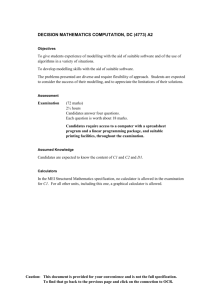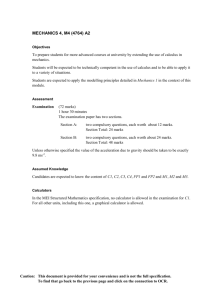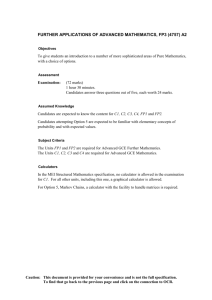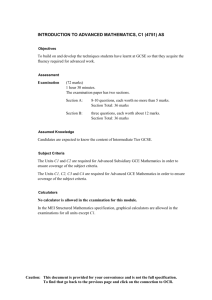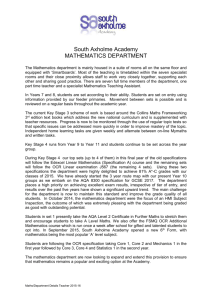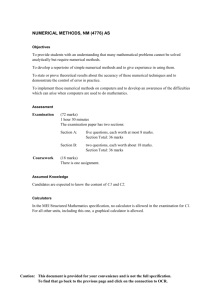DECISION MATHEMATICS 1, D1 (4771) AS
advertisement
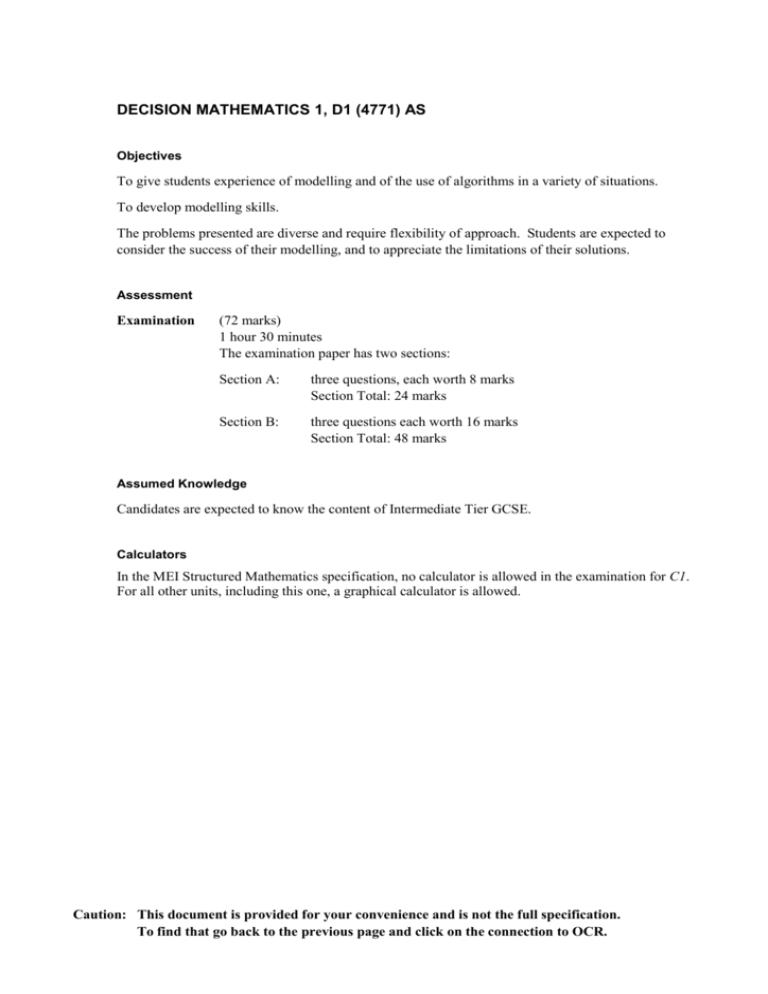
DECISION MATHEMATICS 1, D1 (4771) AS Objectives To give students experience of modelling and of the use of algorithms in a variety of situations. To develop modelling skills. The problems presented are diverse and require flexibility of approach. Students are expected to consider the success of their modelling, and to appreciate the limitations of their solutions. Assessment Examination (72 marks) 1 hour 30 minutes The examination paper has two sections: Section A: three questions, each worth 8 marks Section Total: 24 marks Section B: three questions each worth 16 marks Section Total: 48 marks Assumed Knowledge Candidates are expected to know the content of Intermediate Tier GCSE. Calculators In the MEI Structured Mathematics specification, no calculator is allowed in the examination for C1. For all other units, including this one, a graphical calculator is allowed. Caution: This document is provided for your convenience and is not the full specification. To find that go back to the previous page and click on the connection to OCR. DECISION MATHEMATICS 1, D1 Specification Ref. Competence Statements MODELLING The three units in Decision Mathematics are based on the use of the modelling cycle in solving problems The modelling cycle applied to real-world problems. D1p1 Be able to abstract from a real world problem to a mathematical model. 2 Be able to analyse the model appropriately. 3 Be able to interpret and communicate results. 4 Be able progressively to refine a model as appropriate. ALGORITHMS Background and definition. Basic ideas of complexity. D1A1 Be able to interpret and apply algorithms presented in a variety of formats. 2 Be able to develop and adapt simple algorithms. 3 Understand the basic ideas of algorithmic complexity. 4 Be able to analyse the complexity of some of the algorithms covered in this specification. GRAPHS Background and definitions. Use in problem solving. D1g1 2 Understand notation and terminology. Be able to model appropriate problems by using graphs. NETWORKS Definition. D1N1 Understand that a network is a graph with weighted arcs Use in problem solving. 2 Be able to model appropriate problems by using networks The minimum connector problem. 3 Know and be able to use Kruskal's and Prim's algorithms The shortest path from a given node to other nodes. 4 Know and be able to apply Dijkstra's algorithm Caution: This document is provided for your convenience and is not the full specification. To find that go back to the previous page and click on the connection to OCR. DECISION MATHEMATICS 1, D1 Specification Ref. Competence Statements LINEAR PROGRAMMING Linear inequalities in two or more variables. D1L1 Be able to manipulate inequalities algebraically. 2 Be able to illustrate linear inequalities in two variables graphically. Formulation of constrained optimisation problems. 3 Be able to formulate simple maximisation of profit and minimisation of cost problems. Solution of constrained optimisation problems. 4 Be able to use graphs to solve 2-D problems, including integer valued problems. Algebraic interpretation of the graphical solution in 2 dimensions. 5 Be able to interpret solutions, including spare capacities. CRITICAL PATH ANALYSIS Using networks in project management. D1X1 Be able to construct and use a precedence network. 2 Be able to construct and interpret a cascade chart. 3 Be able to construct and interpret a resource histogram. 4 Understand the use of alternative criteria in project optimisation. 5 Be able to crash a network. Caution: This document is provided for your convenience and is not the full specification. To find that go back to the previous page and click on the connection to OCR. DECISION MATHEMATICS 1, D1 Specification Ref. Competence Statements SIMULATION Random variables. Simulation modelling. D1Z1 Know how to generate realisations of a discrete uniformly distributed random variable. 2 Be able to use random variables to model discrete non-uniform random variables. 3 Be able to build and use simple models. 4 Be able to interpret results. 5 Understand the need for repetition. Caution: This document is provided for your convenience and is not the full specification. To find that go back to the previous page and click on the connection to OCR. Caution: This document is provided for your convenience and is not the full specification. To find that go back to the previous page and click on the connection to OCR.
